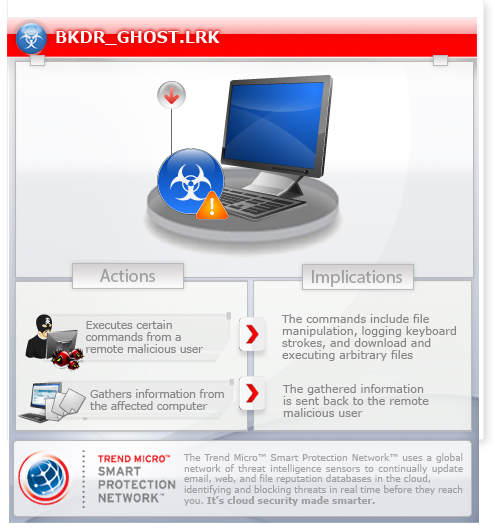BKDR_GHOST.LRK
Windows 2000, Windows Server 2003, Windows XP (32-bit, 64-bit), Windows Vista (32-bit, 64-bit), Windows 7 (32-bit, 64-bit)


Threat Type: Backdoor
Destructiveness: No
Encrypted: Yes
In the wild: Yes
OVERVIEW
Dropped by other malware
This malware is dropped by the malicious .DOC file, TROJ_EXPLOYT.AGH, which takes advantage of the mass stabbing incident in Kunming, China in early March 2014.
To get a one-glance comprehensive view of the behavior of this Backdoor, refer to the Threat Diagram shown below.

This Backdoor may be dropped by other malware.
It executes commands from a remote malicious user, effectively compromising the affected system. It connects to a website to send and receive information.
It gathers certain information on the affected computer.
TECHNICAL DETAILS
122,368 bytes
EXE
Yes
04 Mar 2014
Connects to URLs/IPs, Drops files, Steals information
Arrival Details
This Backdoor may be dropped by the following malware:
Installation
This Backdoor drops the following files:
- %Application Data%\Micbt\IconConfigBt.DAT - Configuration File
- %User Temp%\win_32.sys - encryption table
(Note: %Application Data% is the current user's Application Data folder, which is usually C:\Documents and Settings\{user name}\Application Data on Windows 2000, XP, and Server 2003, or C:\Users\{user name}\AppData\Roaming on Windows Vista, 7, and 8.. %User Temp% is the current user's Temp folder, which is usually C:\Documents and Settings\{user name}\Local Settings\Temp on Windows 2000, XP, and Server 2003, or C:\Users\{user name}\AppData\Local\Temp on Windows Vista, 7, and 8.)
It drops the following copies of itself into the affected system:
- %Application Data%\Micbt\wininit.exe
(Note: %Application Data% is the current user's Application Data folder, which is usually C:\Documents and Settings\{user name}\Application Data on Windows 2000, XP, and Server 2003, or C:\Users\{user name}\AppData\Roaming on Windows Vista, 7, and 8.)
It creates the following folders:
- %Application Data%\Micbt
(Note: %Application Data% is the current user's Application Data folder, which is usually C:\Documents and Settings\{user name}\Application Data on Windows 2000, XP, and Server 2003, or C:\Users\{user name}\AppData\Roaming on Windows Vista, 7, and 8.)
Autostart Technique
This Backdoor drops the following file(s) in the Windows User Startup folder to enable its automatic execution at every system startup:
- %User Startup%\wininit.lnk
(Note: %User Startup% is the current user's Startup folder, which is usually C:\Windows\Profiles\{user name}\Start Menu\Programs\Startup on Windows 98 and ME, C:\WINNT\Profiles\{user name}\Start Menu\Programs\Startup on Windows NT, C:\Documents and Settings\{User name}\Start Menu\Programs\Startup on Windows XP, or C:\Users\{user name}\AppData\Roaming\Microsoft\Windows\Start Menu\Programs\Startup on Windows Vista, 7, and 8.)
Other System Modifications
This Backdoor adds the following registry keys:
HKEY_CURRENT_USER\Software\Microsoft\
Windows\DbxUpdateBT
It adds the following registry entries:
HKEY_CURRENT_USER\Software\Microsoft\
Windows\DbxUpdateBT
Mark = "{data from IconConfigBt.DAT}"
Backdoor Routine
This Backdoor executes the following commands from a remote malicious user:
- File Manipulation
- Capture Screen
- Log Keyboard Strokes
- Download and Executre Arbitrary Files
- Retrieves Cookies
- Record Audio
- Remote Shell Command
- Process Manipulation
It connects to the following websites to send and receive information:
- {BLOCKED}4.{BLOCKED}s.net:80
Information Theft
This Backdoor gathers the following information on the affected computer:
- OS Version
- Username
- Computer Name
- Memory Size (RAM)
- Network Username
- Hardware Information (Processor)
- Drive Information
Other Details
This Backdoor checks for the presence of the following process(es):
- 360Tray.exe
- 360SD.exe
SOLUTION
9.700
10.642.08
04 Mar 2014
10.659.00
11 Mar 2014
Step 1
Before doing any scans, Windows 7, Windows 8, Windows 8.1, and Windows 10 users must disable System Restore to allow full scanning of their computers.
Step 2
Remove the malware/grayware file that dropped/downloaded BKDR_GHOST.LRK. (Note: Please skip this step if the threat(s) listed below have already been removed.)
Step 3
Restart in Safe Mode
Step 4
Delete this registry key
Important: Editing the Windows Registry incorrectly can lead to irreversible system malfunction. Please do this step only if you know how or you can ask assistance from your system administrator. Else, check this Microsoft article first before modifying your computer's registry.
- In HKEY_CURRENT_USER\Software\Microsoft\Windows
- DbxUpdateBT
- DbxUpdateBT
Step 5
Search and delete these folders
- %Application Data%\Micbt
Step 6
Search and delete this file
- %User Startup%\wininit.lnk
- %User Temp%\win_32.sys
Step 7
Restart in normal mode and scan your computer with your Trend Micro product for files detected as BKDR_GHOST.LRK. If the detected files have already been cleaned, deleted, or quarantined by your Trend Micro product, no further step is required. You may opt to simply delete the quarantined files. Please check this Knowledge Base page for more information.
Did this description help? Tell us how we did.


